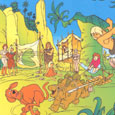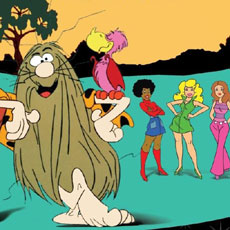Hanna-Barbera (1993), Warner Archive (December 14, 2010), 5 discs, 528 mins plus supplements, 1.33:1 ratio, Dolby Digital 2.0, Rated G, Retail: $34.95
Storyboard:
Two disgraced police officers are assigned dump duty, but continue serving the city as vigilante aviators.

The Sweatbox Review:
By 1990, the glory days of classic Hanna-Barbera productions were largely over. The founders were ready to move onto their own projects after the disappointing process of producing The Jetsons Movie for Universal. (Of course, they could have retired then, too, but both Bill Hanna and Joe Barbera worked into their old age.) Their studio was sold from Great American (formerly Taft) Broadcasting to Turner Productions in 1991, where it became a vital component of Cartoon Network when Turner launched it a year later, and both Bill and Joe worked on directing new shorts for the cable network. The company did find new life on cable, with a number of creator-driven shows appearing there over the next few years, but it certainly wasn’t the same Hanna-Barbera anymore. In 1993, the company also produced a syndicated series that bore little resemblance to anything else in the H-B filmography.

SWAT Kats was created by brothers Christian and Yvon Tremblay, who designed much of the show, while Robert Alvarez did the directing for all the episodes. It ran as part of the weekend syndicated block of programming known as The Funtastic World Of Hanna-Barbera, and was seen on such stations as TBS (you remember— THE SUPERSTATION!). Overseas animation was handled by Seoul-based Hanho Heung-Up Co., Ltd., and it certainly shows in the visuals. The show looks nothing like Secret Squirrel, that’s for sure.

Though I’m a big H-B fan, my first exposure to the show has been the recently released DVD set. First impressions were not good. The first episode, The Pastmaster Always Rings Twice, dropped viewers right into the world of SWAT Kats. While it’s an interesting story premise, with a long-buried wizard being released in the modern day, I was left fairly confused as to the premise of the series. No explanation was given in the initial episode regarding who the SWAT Kats are, or why they do what they do. Characters show up without proper introductions, and it all feels more like an episode from later in the season. Consequently, I really couldn’t care about any of it, and I was left unenthused about watching more. The animation style didn’t help, with too many swooping points of view, and that 80s/90s style of overseas animation that used badly-colored line art backgrounds, and comic-style all-black shading (or big blobs of color) in both backgrounds and figures. Even my kids asked me to never show them an episode of the show again. Not a good sign.

I delayed watching the second episode for all of those reasons, and maybe even fast-forwarded a bit through the next episode, The Giant Bacteria. I love giant single-celled monsters as much as anyone, but still didn’t care about the characters. Ah, but the third episode, The Wrath Of Dark Kat, finally turned things around. This should have been the first episode, as it features a flashback that at last explains just who the SWAT Kats are. First of all, by this time I had realized that they are a pretty small squadron, which threw me off initially. There are in fact just two of them, and as it turns out they are two former members of The Enforcers— Megakat City’s elite police unit. (Everyone in Megakat City is indeed feline in appearance, though this doesn’t particularly figure into the plots; but it does lead to cute names like Calico Briggs, Mayor Manx, Ann Gora, and Dr. Abby Sinnian.) One does get the impression, though, that the city exists all on its own in this world, sort of like Gotham City in Tim Burton’s Batman films, though I was also reminded of Robocop’s Detroit somehow, in terms of being vaguely futuristic and on the verge of collapse.

Chance “T-Bone” Furlong (Charlie Adler) and Jake “Razor” Clawson (Barry Gordon) were Enforcers until the day they tried to take down the evil Dark Kat. Piloting a military-style Enforcers jet, they had Dark Kat targeted, but their superior officer Commander Feral demanded that they let him fly in and save the day. Feral ended up ruining everything, as he clipped Chance and Jake, and sent their aircraft towards Enforcers Headquarters. Mass destruction occurred. Feral refused to take responsibility, and reassigned the two “renegades” to look after a scrap yard. The salvage yard is a dumping point for equipment that is damaged during police actions.
Though T-Bone and Razor are initially disgusted by their humiliating demotion, they make an interesting discovery: With all the military hardware that ends up there, they have the means to build their own jet and continue their policing work as vigilantes. They construct their Turbokat, and later other vehicles like a Turbomole. They create masks for themselves to go with their flight suits, and construct a hangar below the yard. And so are born The SWAT Kats! As the SWAT Kats, Chance and Jake stick to using their nicknames, T-Bone and Razor.
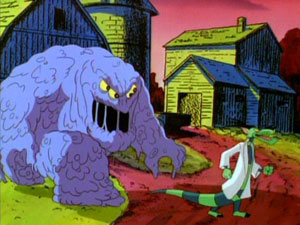
With the origin story out of the way, I began to settle into the show and appreciate its charms. I don’t see it becoming a favorite of mine, seeing as how it is noisy and garish (at least in the first season), and trades military hardware for character development, but it is filled with kooky ideas. Some series you watch for the stories, some because of the characters, and others you just sit back and marvel at the imagination of the writers and artists. Just look at the villains, like Dr. Viper— part cat and part reptile; Mark Hamill provided the voice for Red Lynx, the ghost of a flying ace; and Roddy McDowell played Madkat, a fusion of a deceased mad court jester and an insane modern-day comedian. And then there are Mac and Molly Mange, married gangsters who nearly perish but are rebuilt as The Metallicats. Nutty, but delightful.

Commander Feral continued as a foil for the vigilantes. Feral may be the most dimensional of the characters, as he does occasionally show some intelligence and capability when his ego and arrogance let up for a moment. Mostly, though, he continues to make poor decisions while angrily complaining about the SWAT Kats. Feral was voiced by Gary Owens, and it took a while for me to come to terms with that voice not representing the hero! Much more pleasant is Calico “Callie” Briggs, the pretty deputy mayor, played by Tress MacNeille. Both of the boys are sweet on Callie, who is clearly an intelligent and capable person, even if the writers continually placed her in the “needs-to-be-rescued” role. While Callie seemed to prefer Razor, T-Bone got his own admirer with the introduction of Feral’s niece, Felina, in the second season. Felina worked with her uncle as an Enforcer lieutenant, but had a much better appreciation for the SWAT Kats. She was also much more competent than her uncle.
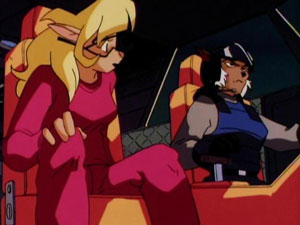
Other standout episodes include the first season closer Katastrophe, which sees four of their major foes team up against them; Razor’s Edge, which actually does some character development as Razor must win his nerve back after apparently accidentally injuring civilians; A Bright And Shiny Future, where The Pastmaster has teamed with The Metallikats to create a future Megakat City made of metal and ruled by them; and The Dark Side Of The SWAT Kats, which sees T-Bone and Razor taking the place of their evil doppelgangers in another dimension.

I did like the animation better as the series progressed, probably because of increased involvement by the Japanese company Mook DLE. By the second season, the show’s look gelled much better, characters were drawn more dynamically and with better style, colors were darker and less garish, and the camera movement was not so overdone. Overall, the artwork simply becomes more pleasing to the eye. Alas, the show only lasted for two seasons, and in fact the last few episodes never reached completion before Hanna-Barbera pulled the plug on the show. Amazingly, the show was the highest rated cartoon in syndication in 1994, so its cancellation seems odd. Theories include a possible decision to tone down violence in their cartoons, a decision to focus more on Cartoon Network properties, or even that Ted Turner simply didn’t care for the show. Whatever the reason, the show ended its run at twenty-five episodes (though four of them in the second season were only about half-length each, and aired in pairs), plus a series-ending overview called SWAT Kats Special Report. Warner Archive has put all of this onto five DVD-Rs. If SWAT Kats can come to Warner Archive, it leaves me hope of seeing other shows, like the rest of The Real Adventures Of Jonny Quest.
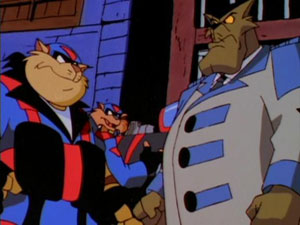
Is This Thing Loaded?
As this is a Warner Archive release, no new bonus material is provided. However, like their previous Hanna-Barbera complete series releases, they have done up menus that allow you to choose which episode to watch, with each episode represented by its title card.
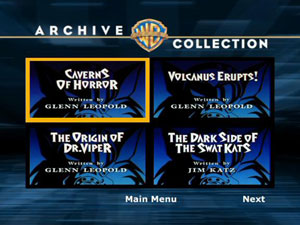
You may also count the SWAT Kats Special Report (22:12) as a bonus feature, as it does stand somewhat apart from the rest of the series (though it is really the final episode, so we can’t award too many points for its inclusion). This full-length episode was done as a news report, and covers the major characters and hardware. It also has a multiple-choice quiz about the show.

Case Study:
Whoever did the cover art needs to be congratulated. The depiction of T-Bone and Razor (with separate front and back cover illustrations) really makes the show look “radical” (in 1990s parlance) — more so than the show itself. It certainly looks more professional than the recent Yogi Bear Warner Archive releases. The case itself is of standard size, and clear. The five DVD-R discs fit on double-sided swinging trays, plus the inside back cover, so no overlapping discs. It’s a nice, tight, attractive package.
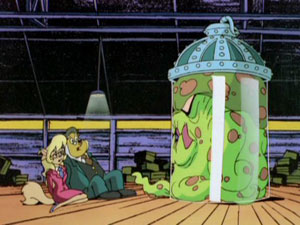
Ink And Paint:
Considering the episodes are not restored, they look pretty darn good. Oh, they do appear a little on the soft side perhaps, but no worse than with many of the retail H-B releases. The prints are in great shape, with very few instances of dirt, and just the tiniest amount of grain. With only five episodes per disc, the compression work had room to breathe (though these are naturally single-layered discs), so there is no artifacting seen, aside from very occasional shimmer.

Scratch Tracks:
The two-channel sound is adequate, and in fact does carry a certain amount of energy. There is no hiss or distortion, with even the electronic music sounding no more obnoxious than it ever did.
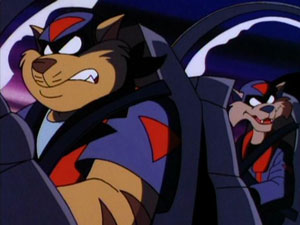
Final Cut:
I wouldn’t expect this Warner Archive release to make too many new fans for the show, as it seems pretty typical of 1980s/1990s efforts to create cool-looking shows with high concepts and little character development… perfect for the needs of toy companies. Indeed, there were at least a few toys produced for the show during its brief time in the spotlight, and even a Super Nintendo video game. However, I have to admit that as the series progressed I began to really enjoy it. The second season certainly looks better than the first, art-wise, and the concepts in the stories are pretty neat. Those that adored the show in their youth will eat this release up, and should be very happy with the video and audio quality. Hanna-Barbera completists will also be interested, and find this a decent if not spectacular purchase. For myself, I’m happy to support the line, as the recent and coming months are treating H-B fans quite well, and I’d like to see that continue.
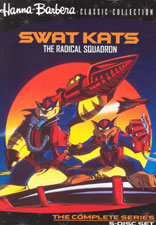 | ||
 |









